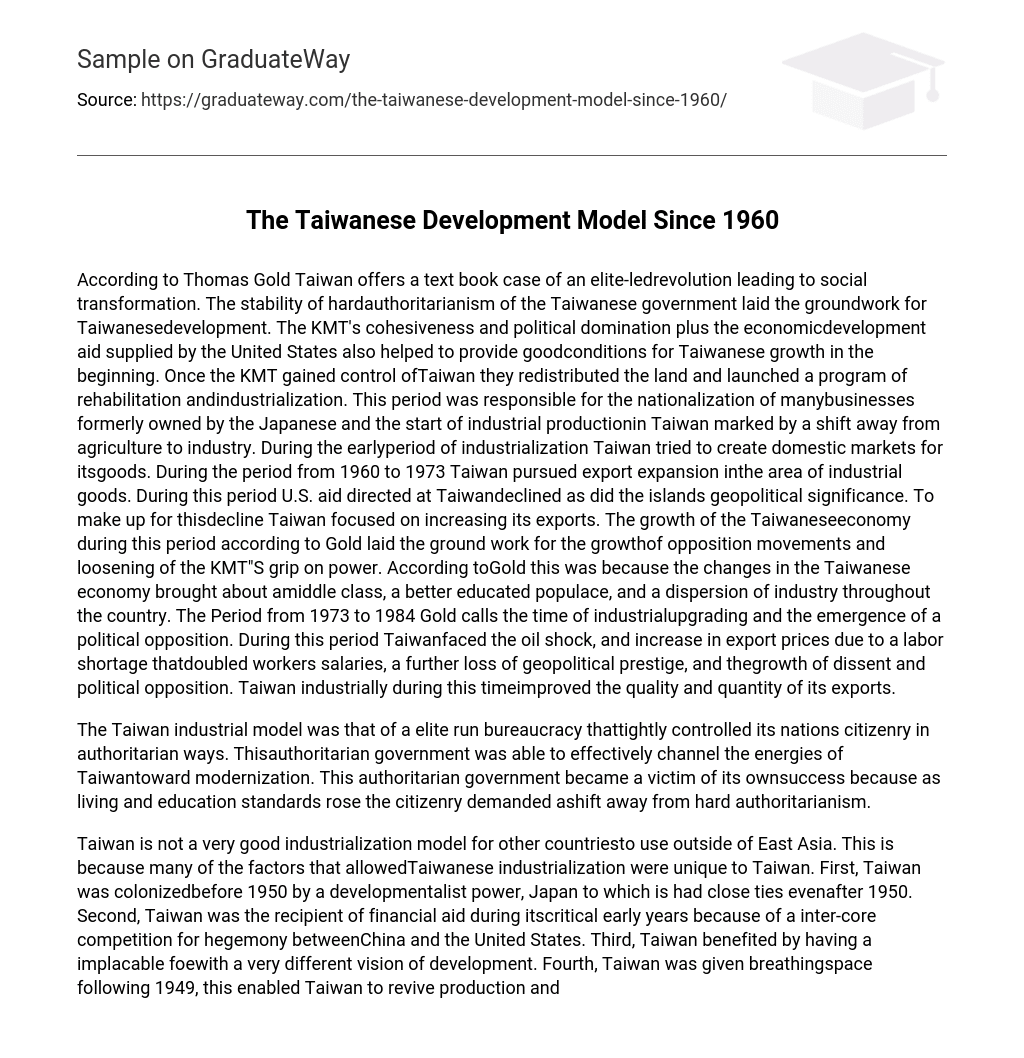According to Thomas Gold Taiwan offers a text book case of an elite-ledrevolution leading to social transformation. The stability of hardauthoritarianism of the Taiwanese government laid the groundwork for Taiwanesedevelopment. The KMT’s cohesiveness and political domination plus the economicdevelopment aid supplied by the United States also helped to provide goodconditions for Taiwanese growth in the beginning. Once the KMT gained control ofTaiwan they redistributed the land and launched a program of rehabilitation andindustrialization. This period was responsible for the nationalization of manybusinesses formerly owned by the Japanese and the start of industrial productionin Taiwan marked by a shift away from agriculture to industry. During the earlyperiod of industrialization Taiwan tried to create domestic markets for itsgoods. During the period from 1960 to 1973 Taiwan pursued export expansion inthe area of industrial goods. During this period U.S. aid directed at Taiwandeclined as did the islands geopolitical significance. To make up for thisdecline Taiwan focused on increasing its exports. The growth of the Taiwaneseeconomy during this period according to Gold laid the ground work for the growthof opposition movements and loosening of the KMT”S grip on power. According toGold this was because the changes in the Taiwanese economy brought about amiddle class, a better educated populace, and a dispersion of industry throughout the country. The Period from 1973 to 1984 Gold calls the time of industrialupgrading and the emergence of a political opposition. During this period Taiwanfaced the oil shock, and increase in export prices due to a labor shortage thatdoubled workers salaries, a further loss of geopolitical prestige, and thegrowth of dissent and political opposition. Taiwan industrially during this timeimproved the quality and quantity of its exports.
The Taiwan industrial model was that of a elite run bureaucracy thattightly controlled its nations citizenry in authoritarian ways. Thisauthoritarian government was able to effectively channel the energies of Taiwantoward modernization. This authoritarian government became a victim of its ownsuccess because as living and education standards rose the citizenry demanded ashift away from hard authoritarianism.
Taiwan is not a very good industrialization model for other countriesto use outside of East Asia. This is because many of the factors that allowedTaiwanese industrialization were unique to Taiwan. First, Taiwan was colonizedbefore 1950 by a developmentalist power, Japan to which is had close ties evenafter 1950. Second, Taiwan was the recipient of financial aid during itscritical early years because of a inter-core competition for hegemony betweenChina and the United States. Third, Taiwan benefited by having a implacable foewith a very different vision of development. Fourth, Taiwan was given breathingspace following 1949, this enabled Taiwan to revive production and consolidatepower without foreign powers interfering. All these factor make Taiwan uniquefrom other nations that would try to copy it. One of the elements that nationsshould not copy from the Taiwan Model according to Gold is Taiwan’s harshauthoritarian government which was much too strictly authoritarian and had ahard time changing as the attitudes of the Taiwanese people changed. (Gold’sbook was published years before the 1996 democratic elections in Taiwan) ButGold does say that Taiwan’s development model does have some lessons that couldbe copied in other nations seeking to industrialize. These are a officialcommitment to development, land redistribution, fostering of agriculture,creation of extra-ministerial ministries to guide development, strategic creditallocation, collection and efficient management of data concerning the economy,investment in infrastructure and human capital, and proper allocation of foreignassistance. Taiwan’s development model was a combination of an orwellian stateand effective ways of industrializing. Taken as a whole the repressiveness ofthe Taiwanese model makes it undesirable for government to adopt; but otheraspects of Taiwan’s industrial policy could prove effective for countriesoutside of the pacific rim.





